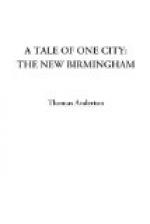Where Gooch Street now crosses the Rea, I remember there was a footbridge, and beyond that the river was a pretty, purling, sylvan stream, with bushes and rushes growing on its green banks. A field walk past an old farm house led on to Moseley Hall, which was looked upon as being quite away in the country. As for Moseley itself, it was a pretty little village in those days. The old village green, the rustic country inns (of which the “Fighting Cocks” was the chief), and some low-roofed, old-fashioned houses, backed by the parish church tower, made up a picture which still remains in my mind’s eye. The railway tunnel which is now looked upon as only a long bridge, was then regarded as something large in its way, and, perhaps, slightly dangerous, almost justifying a little something strong to sustain courage when travelling through it.
Beyond Moseley Church was a pretty road to Moseley Wake Green, in which were, if I remember rightly, one or two timbered houses and some old-fashioned residences, surrounded by high trees. Many of these have now disappeared. In another direction from the church was a country road running to Sparkbrook, and near which were an important house and lands belonging to the wealthy Misses Anderton, whose possessions have been heard of in more recent days.
I now often visit Moseley, and change, but not decay, in all around I see. The prevailing colour of the old village green is now red brick, and the modern colour does not agree so well with my vision as the more rustic tones of a bygone day; whilst the noise and bustle of tram cars, the swarms of suburban residents that emerge from the railway station (especially at certain times in the day), are fast wiping out the peaceful, pretty Moseley of my youthful days.
These new old villages often present some curious anachronisms. A grey old church, partly buried by a hoary fat churchyard, is surrounded by the most modern of shops and stores; and a primitive little bow-windowed cottage, with a few flower pots in the window, has, perchance, a glaring gin shop next door. This is more or less the case at Moseley, and it is pretty much the same at Handsworth.
I remember when old Handsworth Church stood surrounded by fields, and now it is built up to with villas on nearly every side, and has a neighbouring liquor vault instead of the old-fashioned inn such as often keeps old parish churches in countenance and affords a place of refuge and refreshment for rustic churchwardens, bell-ringers, parish clerks, and the like.
Old Handsworth—how well I remember it—also Soho, and the remains of the old mint, associated with the honoured names of Boulton and Watt. Then there was that long straight stretch of road from the old pike at the top of Soho Hill, along which were some large and important residences, occupied by business men of Birmingham, who doubtless regarded this Handsworth and Soho district as being quite out in the country. The stretch of road to which I have just referred is now one long street, or soon will be, reaching from the once Soho toll-gate to the New Inns, and farther on, indeed, to the park wall of Sandwell.




